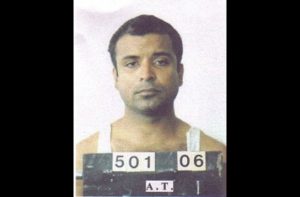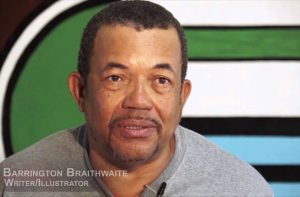…Braithwaite says PPP was losing ability to govern the country
RIGHTS activist and social commentator, Barrington Braithwaite has long contended that violent crimes fueled by extra-judicial killings here escalated under the watch of the Bharrat Jagdeo Administration. But even before that, he is now saying, there were signs that the People’s Progressive Party/Civic (PPP/C) was losing its ability to govern the country.
As Braithwaite contends, under Jagdeo’s watch as president (which spanned August 11, 1999 to December 3, 2011), there were three massacres: The Lusignan Massacre, where 11 people were killed; The Bartica Massacre, where another 12 were killed; and the Lindo Creek massacre, where eight miners were slaughtered.
Besides, there were countless extra-judicial killings, with some activists estimating that around 400 Afro-Guyanese males were gunned down. Braithwaite had designed the Buxton Monument, on which is inscribed the names of over 450 Guyanese who were murdered during the period at reference. He has long advocated for justice to be served for the crimes committed against humanity.

And as he sat down recently with the Guyana Chronicle for an exclusive interview, Braithwaite turned back the pages of history to May 1996 when 20-year-old Jermaine Wilkinson was killed, allegedly at the hands of a serving policeman. For Braithwaite, Wilkinson’s death was one of the early signs that the PPP/C Administration was losing its ability to maintain peace, law and order.
Wilkinson died on a hospital bed hours after he was shot by a member of the Police Impact Patrol, Robert Beresford, who had earlier in the day arrested him in Albouystown. His death had ignited a series of street protests, which had resulted in Beresford being charged with manslaughter. “According to an eyewitness who was there when Beresford shot Wilkinson,” Braithwaite said, “he gave his gun to Wilkinson’s brother to hold, and tried to lift Wilkinson, causing many who witnessed the incident to assume that Corporal Beresford was high on something.” As Braithwaite observed, “it was highly suspected at the time that the police were dabbling in drugs.”
Cocaine had penetrated the country by then, he said, as he cited the December 1994 case of ‘Baby Arthur’, a former soldier named Hubert Headley, who, with the aid of a cane-cutter’s cutlass, chopped to death several persons, including his own mother, and a white dog at the Friendship Middle Walk, on the East Coast Demerara. That incident occurred on December 9, 1994.
‘Baby Arthur’ was a known cocaine addict at the time he committed the beastly act in his village. He was reportedly shot dead by the police minutes later, after he famously refused to “surrender”, and was proceeding menacingly towards them, dancing and singing while turning the odd cartwheel, machete in hand. From then on, the gun and drug-related crimes would continue unabated, but by the early 2000s, the situation, according to Braithwaite, had spiraled out of control. He contends that by July 2001 when the ‘Mandela Trio’ was gunned down by the ‘Target Special Squad’, extra-judicial killings had been officially sanctioned. “There was a ‘green light’ on executing people back then,” Braithwaite opined while contending that under the Jagdeo Administration, the Ministry of Home Affairs, led by then Minister of Home Affairs Ronald Gajraj had empowered the ‘Target Special Squad’.
The situation, he posited, had quickly moved from bad to worse by February 23, 2002, when five of Guyana’s most dangerous criminals escaped from the Camp Street Prison. ‘The Famous Five’, as the gang came to be known, comprised of Dale Moore, Troy Dick, Andrew Douglas, Shawn Brown and Mark Fraser. Four members of the quintet were on remand for charges of murder and robbery, while Fraser was serving a 25-year sentence for robbery under arms. The presence of the five men on the streets saw a massive crime wave sweep across Guyana.
Drug lords
“When they escaped,” Braithwaite said, “their target seemed to have been a specific ‘drug lord’ or perceived drug lord. Then they started taking contracts, but there was a kind of ‘hands-off’ on these guys.” Noting that he did not grow up “covered or sheltered”, Braithwaite disclosed that he knew Shawn Brown, as well as Dale Moore and his father. While some have suggested that the escapees had fled to Buxton almost immediately, Braithwaite explained that it was only after the ‘Target Special Squad’ had killed Shaka Blair, a Buxtonian father of three, on April 6, 2002 that the criminals turned to Buxton. According to him, prior to that, the escapees were housed approximately five houses from where the then Minister of Home Affairs was living at the time. “These guys were managed,” the rights’ activist said.
He disclosed, too, that ‘Death Squad’ informant, George Bacchus, was also known to him and shared some dark secrets with him. It was Bacchus, who, before he was murdered in his sleep, disclosed that he was invited to the home of the then Home Affairs Minister, and was asked to supply then suspected ‘hitman’ Axel Williams with information.
The Stabroek News on June 27, 2004, reported that Bacchus, in one of two sworn affidavits, which was handed over to the police after he was shot and killed, implicated the PPP Home Affairs Minister, linking him to the ‘Death Squad’. “The affidavits, dated June 11, were drawn up by attorney Basil Williams, on the instructions of the self-confessed ex-informant, who claimed to have been a regular visitor to the home of the internal security minister,” the Stabroek News reported.
Bacchus had levied the allegations against the minister, after his brother, Shafeek Bacchus, was killed in a drive-by shooting. Again, according to the Stabroek News, there were three persons who were charged with the murder of Shafeek Bacchus: Funeral Home owner, Ashton King; Sean Hinds; and Mark Thomas, who subsequently died.

According to Bacchus, he later learnt that the information he was providing to the Home Affairs Minister, Axel Williams and the two policemen, were not only being used to execute criminals, but law-abiding citizens as well. Stabroek News reported that Bacchus took note of the fact that even after most of the 2002 prison escapees had been killed, the executions continued. He was reportedly shown another list of names by Williams for the supply of information on where to find those persons. “…I did not provide any information on those persons, and in fact warned some of them on the list to be careful and go into hiding,” Bacchus was quoted by the Stabroek News as saying.
In that very article, the Stabroek News reported: “The ex-informant said when Minister Gajraj did nothing about his reports that the men were still killing, he began to tell people about their activities, and that he rather suspected that the ‘hitmen’ were annoyed, because they had started to behave strangely towards him. This caused him to grow afraid that they would kill him too, and as such he decided to share his suspicions with persons whom he described as ‘important people’
Roger Khan
By 2003, convicted drug-trafficker, Shaheed Roger Khan had inserted himself unto the scene. Between 2003 and 2006, Khan had set up a criminal network in Guyana, a network that included active policemen and a number of former ranks, ostensibly to go after criminals, but at the same time protecting his narco-trafficking interests. He was nabbed in neighbouring Suriname in 2006 while fleeing local police, and was later handed over to U.S. authorities, and was sentenced. He has since completed serving his sentence, and is scheduled to return to Guyana soon. Although the PPP government had sought to distance itself from Khan, the drug-trafficker had stated publicly in a paid advertisement in local newspapers that he was fighting crime on behalf of the Jagdeo-led government.
Khan had also implicated then Government Minister Dr. Leslie Ramsammy in his escapades, and documents bearing the then minister’s signature authorising the purchase of a sophisticated wire-tapping device were produced in U.S. courts during Khan’s trial.
Khan was responsible for a number of murders, robberies and shootings, and Braithwaite believes that he, along with the intellectual authors of the crimes committed between the early 2000s and 2009 should be held accountable. “Roger Khan made himself the poster-boy, and if he is the poster-boy, you have to go after him and follow the tentacles,” Braithwaite said, adding: “Selwyn Vaughn, who had infiltrated Khan’s group, confirmed that he was responsible for Waddell’s death… How do you not deal with that? He didn’t kill Ronald Waddell in Brooklyn; he was killed here in Guyana.”
Vaughn had made the disclosure while testifying before a US Court in the ‘Roger Khan’ case. According to Vaughn, Khan had ordered the killings of political activist Ronald Waddell, and boxing coach Donald Allison. “What he served a sentence for in America was for selling drugs to America, what he did here has to be dealt with here,” Braithwaite told this newspaper. He was keen on noting that Khan is not the only one responsible, emphasizing that many of the intellectual authorities and hitmen are still alive, simply ‘clothes in different garments.’



.jpg)









